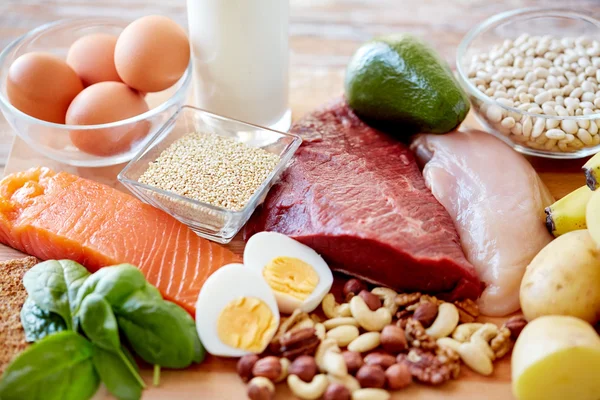Discover “Crafting a Nutrient-Rich Diet” When it comes to a healthy diet, there’s no one-size-fits-all solution. The key to achieving optimal health and well-being lies in making your dietary choices uniquely tailored to your needs. In this article, we’ll delve into the essential aspects of crafting a nutrient-rich diet that’s tailored just for you.

The Pitfalls of Generic Diets
Before we explore the magic of personalization, let’s understand why cookie-cutter diets often fall short:
- One-Size-Fits-All Approach: Generic diets rarely consider individual variations in metabolism, lifestyle, and dietary restrictions, making them a poor fit for most people.
- Sustainability Issues: Following a diet that doesn’t align with your preferences is challenging in the long run, leading to cravings and eventual setbacks.
- Lack of Enjoyment: Enjoying what you eat is crucial. A diet that doesn’t satisfy your taste buds can lead to dissatisfaction and ultimately, diet abandonment.
The Power of Personalization
Now, let’s uncover how personalization is the key to a healthy, sustainable diet:
- Tailored Nutrition: Personalization allows you to choose foods that provide the essential nutrients your body needs. For instance, if you’re iron-deficient, your diet can be enriched with iron-rich foods.
- Flexible Approach: With a personalized diet, you have the flexibility to indulge in occasional treats while still meeting your health goals.
- Adaptability: As your goals and preferences evolve, your personalized diet can evolve with you, ensuring that it remains in sync with your life.
What Does “Healthy Diet” Mean to You?
To me, a healthy diet is one that provides the body with all the nutrients it needs to function properly and stay healthy. It includes a variety of foods from all food groups, including fruits, vegetables, whole grains, lean protein, and healthy fats. A healthy diet is also one that is low in processed foods, added sugar, and unhealthy fats.
Here is a more detailed breakdown of what I consider to be a healthy diet:
- Fruits and vegetables: Fruits and vegetables are packed with vitamins, minerals, and antioxidants, which are essential for good health. Aim to eat at least 5 servings of fruits and vegetables per day.
- Whole grains: Whole grains are a good source of fiber, which can help to improve digestion and keep you feeling full. They are also a good source of other nutrients, such as B vitamins and vitamin E. Choose whole grains over refined grains whenever possible.
- Lean protein: Lean protein is essential for building and repairing muscle tissue. It is also a good source of other nutrients, such as iron and zinc. Good sources of lean protein include chicken, fish, beans, lentils, and tofu.
- Healthy fats: Healthy fats are important for brain health, heart health, and overall health. Good sources of healthy fats include olive oil, avocado oil, nuts, and seeds.
It is also important to limit your intake of processed foods, added sugar, and unhealthy fats. Processed foods are often high in unhealthy fats, added sugar, and sodium. They are also low in nutrients. Added sugar is a major contributor to weight gain and other health problems. Unhealthy fats, such as saturated and trans fats, can raise cholesterol levels and increase the risk of heart disease.
What Does a Nutrient in a Rich Diet Consist Of?
A nutrient-rich diet consists of foods that are high in nutrients and low in calories, unhealthy fats and added sugar. Nutrient-rich foods are essential for good health, as they provide the body with the nutrients it needs to function properly and stay healthy.
Here are some examples of nutrient-rich foods:
- Fruits and vegetables: Fruits and vegetables are packed with vitamins, minerals, and antioxidants, which are essential for good health. Some examples of nutrient-rich fruits and vegetables include:
- Berries
- Citrus fruits
- Leafy green vegetables
- Broccoli
- Tomatoes
- Carrots
- Sweet potatoes
- Whole grains: Whole grains are a good source of fiber, which can help to improve digestion and keep you feeling full. They are also a good source of other nutrients, such as B vitamins and vitamin E. Some examples of whole grains include:
- Brown rice
- Quinoa
- Oats
- Whole-wheat bread and pasta
- Lean protein: Lean protein is essential for building and repairing muscle tissue. It is also a good source of other nutrients, such as iron and zinc. Some examples of lean protein include:
- Chicken
- Fish
- Beans
- Lentils
- Tofu
- Healthy fats: Healthy fats are important for brain health, heart health, and overall health. Some examples of healthy fats include:
- Olive oil
- Avocado oil
- Nuts
- Seeds
A nutrient-rich diet typically consists of a variety of foods from all food groups. However, it is important to note that everyone’s individual needs may vary depending on their age, sex, activity level, and any underlying health conditions. If you have any questions or concerns about following a nutrient-rich diet, be sure to talk to your doctor or a registered dietitian.
Foods to Incorporate Into a Healthy, Balanced Diet
Here are some foods to incorporate into a healthy, balanced diet:
- Fruits and vegetables: Fruits and vegetables are packed with vitamins, minerals, and antioxidants, which are essential for good health. Aim to eat at least 5 servings of fruits and vegetables per day.
- Whole grains: Whole grains are a good source of fiber, which can help to improve digestion and keep you feeling full. They are also a good source of other nutrients, such as B vitamins and vitamin E. Choose whole grains over refined grains whenever possible.
- Lean protein: Lean protein is essential for building and repairing muscle tissue. It is also a good source of other nutrients, such as iron and zinc. Good sources of lean protein include chicken, fish, beans, lentils, and tofu.
- Healthy fats: Healthy fats are important for brain health, heart health, and overall health. Good sources of healthy fats include olive oil, avocado oil, nuts, and seeds.
Here is a sample meal plan that incorporates a variety of nutrient-rich foods:
Breakfast:
READ RELATED: 4 Common Triggers of Headaches and Mental Symptoms and How to Prevent or Ease Them
- Oatmeal with berries and nuts
- Yogurt with fruit and granola
- Whole-wheat toast with avocado and eggs
Lunch:
- Salad with grilled chicken or fish
- Lentil soup and whole-wheat bread
- Turkey sandwich on whole-wheat bread with vegetables
Dinner:
- Salmon with roasted vegetables
- Chicken stir-fry with brown rice
- Lentil tacos
Snacks:
- Fruits and vegetables
- Nuts and seeds
- Yogurt
This is just a sample meal plan, and you can adjust it to fit your own preferences and dietary needs. Be sure to drink plenty of water throughout the day as well.
Everyday Tips to Plan a Healthier Diet
Here are some everyday tips to plan a healthier diet:
- Start with a plan. Take some time each week to plan out your meals and snacks. This will help you to make sure that you have healthy and nutritious foods on hand, and it will also help you to avoid making impulse decisions when you’re hungry.
- Make a list and stick to it. When you go grocery shopping, make a list of the healthy foods that you need to buy. Stick to your list as much as possible, and avoid buying processed foods or junk food.
- Cook more meals at home. Cooking at home allows you to control the ingredients in your food. It also allows you to make healthier versions of your favorite dishes.
- Read food labels carefully. Pay attention to the serving size and the amount of calories, fat, sugar, and sodium in each serving. Choose foods that are low in unhealthy fats, added sugar, and sodium.
- Make healthy substitutions. There are many ways to make healthier substitutions in your diet. For example, instead of using white bread, use whole-wheat bread. Instead of using butter, use olive oil. Instead of using sugary drinks, drink water or unsweetened tea.
Here are some additional tips:
- Eat plenty of fruits and vegetables. Fruits and vegetables are packed with vitamins, minerals, and antioxidants, which are essential for good health. Aim to eat at least 5 servings of fruits and vegetables per day.
- Choose whole grains over refined grains. Whole grains are a good source of fiber, which can help to improve digestion and keep you feeling full. They are also a good source of other nutrients, such as B vitamins and vitamin E. Choose whole grains over refined grains whenever possible.
- Choose lean protein sources. Lean protein is essential for building and repairing muscle tissue. It is also a good source of other nutrients, such as iron and zinc. Good sources of lean protein include chicken, fish, beans, lentils, and tofu.
- Limit your intake of processed foods, added sugar, and unhealthy fats. Processed foods are often high in unhealthy fats, added sugar, and sodium. They are also low in nutrients. Added sugar is a major contributor to weight gain and other health problems. Unhealthy fats, such as saturated and trans fats, can raise cholesterol levels and increase the risk of heart disease.
By following these tips, you can plan a healthier diet that will help you to improve your overall health and well-being.
Which Diets Are Healthy for Most People?
There are many different diets that are considered to be healthy for most people. Some of the most popular and well-studied diets include:
- Mediterranean diet: The Mediterranean diet is a plant-based diet that is rich in fruits, vegetables, whole grains, legumes, nuts, and seeds. It also includes moderate amounts of fish and poultry, and limited amounts of red meat and processed foods. The Mediterranean diet has been linked to a number of health benefits, including a reduced risk of heart disease, stroke, and type 2 diabetes.
- Dash diet: The Dash diet, or Dietary Approaches to Stop Hypertension diet, is a low-sodium diet that is designed to lower blood pressure. The Dash diet is similar to the Mediterranean diet, but it places an even greater emphasis on reducing sodium intake. The Dash diet has been shown to be effective in lowering blood pressure and reducing the risk of heart disease and stroke.
- Flexitarian diet: The flexitarian diet is a semi-vegetarian diet that allows for occasional consumption of meat and fish. The flexitarian diet is a good option for people who want to reduce their meat intake but are not ready to become completely vegetarian or vegan. The flexitarian diet has been linked to a number of health benefits, including a reduced risk of heart disease, stroke, and type 2 diabetes.
- Volumetrics diet: The Volumetrics diet is a low-calorie diet that focuses on eating foods that are low in calories but high in volume. Foods that are low in calories but high in volume include fruits, vegetables, whole grains, and legumes. The Volumetrics diet has been shown to be effective for weight loss and weight maintenance.
It is important to note that there is no one-size-fits-all approach to healthy eating. The best diet for you is the one that you can stick to and that meets your individual needs and preferences. If you have any underlying health conditions, be sure to talk to your doctor before making any major changes to your diet.
Here are some tips for choosing a healthy diet:
- Choose a diet that is based on whole, unprocessed foods.
- Make sure your diet includes a variety of foods from all food groups, including fruits, vegetables, whole grains, lean protein, and healthy fats.
- Limit your intake of processed foods, added sugar, and unhealthy fats.
- Choose a diet that you can stick to over the long term.
If you are unsure which diet is right for you, talk to your doctor or a registered dietitian. They can help you to develop a personalized diet plan that meets your individual needs and goals.
Involve Your Healthcare Provider
Involving your healthcare provider in your diet plan can be a great way to ensure that you are eating a healthy and balanced diet that meets your individual needs. Your healthcare provider can help you to:
- Identify any dietary restrictions or concerns. If you have any underlying health conditions, such as diabetes, heart disease, or kidney disease, your healthcare provider can help you to identify any dietary restrictions or concerns that you need to be aware of.
- Create a personalized diet plan. Your healthcare provider can work with you to create a personalized diet plan that meets your individual needs and goals. For example, if you are trying to lose weight, your healthcare provider can help you to create a calorie-restricted diet plan that is also nutritionally sound.
- Provide support and guidance. Your healthcare provider can provide you with support and guidance as you implement your new diet plan. They can also help you to troubleshoot any challenges that you may be facing.
Here are some tips for involving your healthcare provider in your diet plan:
- Schedule an appointment. Talk to your healthcare provider about your interest in creating a healthier diet plan. They can schedule an appointment to discuss your individual needs and goals in more detail.
- Be prepared to discuss your current diet. Be prepared to discuss your current diet with your healthcare provider. This will help them to identify any areas where you may need to make changes.
- Ask questions. Don’t be afraid to ask your healthcare provider questions about your diet plan. They are there to help you, and they want to make sure that you are successful.
Here are some questions you can ask your healthcare provider about your diet plan:
- What foods should I eat more of?
- What foods should I eat less of?
- How many calories do I need to eat each day?
- What nutrients do I need to make sure I’m getting enough of?
- How can I make healthy substitutions for my favorite unhealthy foods?
- What are some tips for sticking to a healthy diet plan?
Your healthcare provider is a valuable resource for creating a healthy diet plan that meets your individual needs and goals. By involving them in your diet plan, you can increase your chances of success.
Summary
In summary, the key to a healthy diet is making it your own. By selecting fresh, wholesome ingredients, balancing macronutrients, practicing portion control, staying hydrated, meal planning, listening to your body, and embracing flavors, you can create a dietary plan that suits your individual needs. Don’t forget to consult with a professional for personalized guidance. Your journey to a healthier you begins with the choices you make at every meal.









